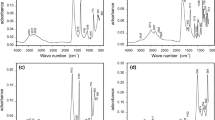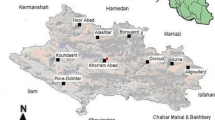Summary
In vitro studies have demonstrated that trace elements have inhibitory as well as stimulatory effects on the crystallization of urinary stones. Little is known about the activities of rare-earth elements (REEs) in the human body. Although their physiological role is unclear, an effect on calcium transport mechanisms is discussed. In the present study, ten kidney stones (six oxalate and four phosphate stones) were analyzed by neutron-activation analysis for their REE patterns. Urinary stones are capable of concentrating these elements, and some fractionation into light and heavy REEs appears to take place during deposition. Significantly elevated concentrations of heavy REEs such as europium, terbium, and lutetium were detected in phosphate stones as compared with oxalate stones (P<0.005).
Similar content being viewed by others
References
Bowen VT, Rubinson AC (1951) Uptake of lanthanum by a yeast. Nature 167:1032
Diezel W, Gruner S, Diaz LA, Anhalt GJ (1989) Inhibition of cutaneous contact hypersensitivity by calcium transport inhibitors lanthanum und diltiazem. Invest Dermatol 93:322
Elliot JS, Eusebio E (1967) Calcium oxalate solubility: the effect of trace metals. Invest Urol 5:428
Erametsa O, Sihvonen ML (1971) Rare earths in the human body: II. Yttrium and lanthanides in the spleen. Ann Med Exp Biol Fenn 49:35
Esposito W, Oddone M, Accardo S, Cutolo M (1986) Concentrations of lanthanides in plasma and synovial fluid in rheumatoid arthritis. Clin Chem 32:1598
Eusebio E, Elliot JS (1967) Effect of trace metals on the crystallization of calcium oxalate. Invest Urol 5:431
Evans CH (1990) Biochemistry of the lanthanides. Plenum, New York London, p 286
Grant WM, Kern HL (1956) Cations and the cornea. Toxicity of metals to the stroma. Am J Ophthalmol 42:167
Gross MD, Nelsestuen GL, Kumar R (1987) Observations on the binding of lanthanides and calcium to vitamin D-dependent chick intestinal calcium-binding protein. Implications regarding calcium-binding protein function. Biol Chem 262:6539
Henderson P (1984) Rare earth element geochemistry. Elsevier, Amsterdam, p 1
Hesse A, Dietz HJ, Berg W, Hienzsch E (1977) Mass spectrometric trace element analysis of calcium oxalate uroliths. Eur Urol 3:359
Hofbauer J, Steffan I, Höbarth K, Vujicic G, Schwetz H, Reich G, Zechner O (1991) Trace elements and urinary stone formation: new aspects of the pathological mechanism of urinary stone formation. J Urol 145:93
Joost J, Tessadri R (1987) Trace element investigations in kidney stone patients. Eur Urol 13:264
Kiss J, Banoczy J, Fehervary E, Gintner Z, Albrecht M (1990) Production of cerium-apatite in sound and carious dental enamel under in vitro conditions. Acta Morphol Hung 38:61
Koeberl C (in press) Instrumental neutron activation analysis of geochemical and cosmochemical samples: a fast and reliable method for small sample analysis. J Radional Nucl Chem
Koeberl C, Bayer PM (1992) Concentrations of rare earth elements in human brain tissue and kidney stones determined by neutron activation analysis. J Alloys Compounds 180:63
Koeberl C, Kluger F, Kiesl W (1987) Rare earth element determinations at ultratrace abundance levels in geologic materials. J Radioanal Nucl Chem 112:481
Lepel EA, Laul JC (1986) Trace rare earth element analysis of IAEA hair (HH-1), animal bone (H-5) and other biological standards by radiochemical neutron activation. In: Proceedings, 7th Conference on Modern Trends in Activation Analysis, Copenhagen, p 417
Levinson AA, Nosal M, Davidman M, Prien EL Sr, Prien EL Jr, Stevenson RG (1978) Trace elements in kidney stones from three areas in the United States. Invest Urol 15:270
Maclntyre DE, Shaw AM, Bushfield M, McMillian LJ, McNicol A, Pollock WK (1985) Endogenous and pharmacological mechanism for the regulation of human platelet cytosolic free Ca2+. Nouv Rev Fr Hematol 27:285
Meyer JL, Angino EE (1977) The role of trace metals in calcium urolithiasis. Invest Urol 14:347
Sabbioni E, Pietra R, Gaglione P, Vocaturo G, Colombo F, Zanoni M, Rodi F (1982) Long-term occupational risk of rare-earth pneumoconiosis. A case report investigated by neutron activation analysis. Sci Total Environ 26:19
Scott R, East BW, Janczyszyn J, Boddy K, Yates AJ (1980) Concentration and distribution of some minor and trace elements in urinary tract stones; a preliminary study. Urol Res 8:167
Sotiruoudis TG (1986) Lanthanide ions and Cd2+ are able to substitute for Ca2+ in regulation of phosphorylase kinase. Biochem Int 13:59
Varga S, Csermely P, Mullner N, Dux L, Martonosi A (1987) Effect of chemical modification on the crystallization of Ca2+-ATPase in sarcoplasmic reticulum. Biochim Biophys Acta 896:187
Welshman SG, McGeown MG (1972) A quantitative investigation of the effects on the growth of calcium oxalate crystals of potential inhibitors. Br J Urol 44:677
Wester PO (1965) Trace elements in human myocardial infarction determined by neutron activation analysis. Akt Atom Stockh AE 188:31
Yamage M, Evans DH (1989) Suppression of nitrogen- and antigen-induced lymphocyte proliferation by lanthanides. Experientia 45:1129
Author information
Authors and Affiliations
Rights and permissions
About this article
Cite this article
Höbarth, K., Koeberl, C. & Hofbauer, J. Rare-earch elements in urinary calculi. Urol. Res. 21, 261–264 (1993). https://doi.org/10.1007/BF00307707
Received:
Accepted:
Issue Date:
DOI: https://doi.org/10.1007/BF00307707




